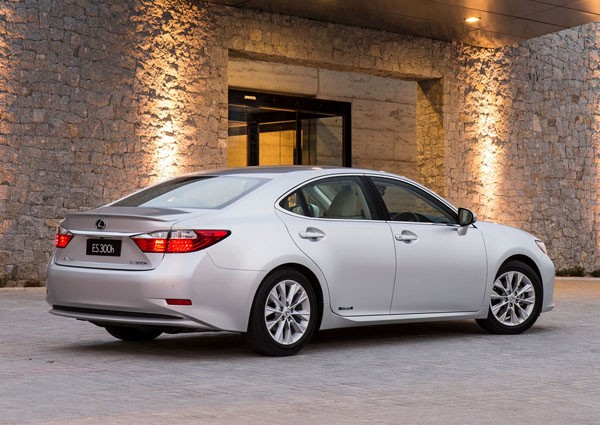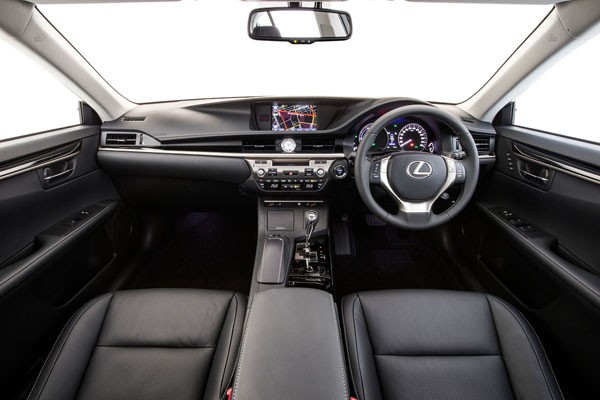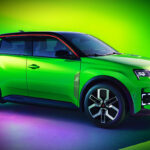The Lexus ES 300 was one of the pioneers of the Japanese prestige brand when it arrived here in 1992. For a number of reasons, not least comparisons with the Toyota Camry on which it was based, it was always in the shadow of its big brother the LS series.
As a variety of other models were added to the Lexus range the ES 300 continued to struggle and, in 2008, was dropped from the Australian line-up altogether. In late 2013 the ES line, as it is now called, returned this time reinvigorated by an all-new E 350 model with a V6 petrol engine of 3.5 litres compared to the previous 3.0.
The big news was a petrol/electric hybrid version called the ES 300h.

Each model comes in two specification levels, Luxury and Sports Luxury, the latter adding $9000 to the price of both ES 350 and E 300h. Unusually the two hybrids are $2000 cheaper than the equivalent V6s although some equipment has been cut from the hybrid with the aim of meeting Lexus’s target of a 50/50 sales split between V6 and hybrid models.
STYLING
The relatively bland looks of the original ES have been replaced by a much more aggressive style built around the signature Lexus arrow-head spindle grille. Projector-style halogen headlamps and LED daytime running lights enhance the frontal appearance while the relatively conservative rear also gets LED lights, and twin chrome-tipped exhaust pipes.
Apart from badging the only visible difference between the petrol and hybrid models is a small spoiler on the top of the boot of the ES 300h.

The dashboard is almost a work of art with its flowing lines and combination of hand-stitched leather and wood inserts, that carry over to the steering wheel. The controls are well-placed and easy to use with the noticeable exception of the rectangular ‘mouse’ controller. It’s far too light in its movements, almost dangerously so if there isn’t a front seat passenger to operate it.
ENGINES / TRANSMISSIONS
The 3.5-litre V6 engine in the ES 350 peaks at 204 kW with maximum torque is 346 Nm at 4700 revs and is mated to a conventional six-speed automatic transmission
The ES 300h combines a 2.5-litre Atkinson Cycle four-cylinder petrol engine with nickel-metal-hydride batteries to provide 151 kW and 213 Nm at 4500 rpm. It combines with the extra efficiently of a continuously variable transmission (CVT).
Official fuel consumption from the ES 300h is rated at 5.5 litres per 100 kilometres. We used around 7.1 L/100 km, a fair bit higher, but still impressive for what is a relatively large car.
SAFETY
Standard features in all ES variants include ten airbags; ABS brakes with electronic brakeforce distribution, brake assist and emergency braking signal; stability and traction control; pedestrian protection system; tyre pressure warning; blind spot monitoring; hill-start assist; parking sensors; and rear vision camera.
Optional in the ES 300h Luxury and standard in the other three models is the Lexus Pre-Collision Safety (PCS) system that combines active and passive safety features that send out beeps and hazard light flashing when a crash appears imminent and then applies emergency braking if the driver hasn’t down so.
The ES 300h has regenerative braking, using the electric drive motor as a generator as well as electronically controlled braking.
INFOTAINMENT
Standard across the range are satellite navigation; Mark Levinson 15-speaker Premium Surround Sound System; Bluetooth telephone and audio streaming; USB and Auxiliary sockets; and 3.5-inch full colour multi-information display.
DRIVING
As we’ve grown used to from nearly 25 years of driving Lexus cars the new ES models ooze quality and refinement. The seats are soft but reasonably supportive, with rear legroom that matches the standard wheelbase Lexus LS. Rear seat headroom is fine for all but the tallest of occupants.
The CVT is right up there with the most unobtrusive that we’ve driven and reacts well to the instant torque that the electric motor supplies.
Suspension is softer than we like but makes sense given Lexus ES line’s potential clients are looking for luxury cruising rather than any sort of driving excitement.
The big hybrid was in its element during our 60 km motorway between Sydney and the Central Coast, purring along in a manner that suggested it could keep going all the way to Brisbane without a fuel stop. With conservative driving there’s no doubt that it would so, with fresh and relaxed occupants disembarking at the other.
SUMMING UP
In addition to the undoubted class and the environmental benefits of the new Lexus ES 300h it offers remarkable value. With a starting price of $63,000 (plus on-roads) it’s nearly $22,000 cheaper than the previous Lexus ES 300 when it was launched in 2001.
Factoring in the vastly superior level of technology and equipment in the new model and the difference becomes even more emphatic. Indeed, but for the extra status it’s hard to see why anyone would fork out an extra $150,000-plus for its Lexus LS 600h big brother.
Unlike its European rivals the Lexus ES 300h also comes with a four-year standard warranty, albeit with a 100,000 km limit.
MODEL RANGE
ES 300h Luxury 2.5-litre petrol / electric hybrid four-door sedan: $63,000 (CVT automatic)
ES 300h Sports Luxury 2.5-litre petrol / electric hybrid four-door sedan: $72,000 (CVT automatic)
ES 350 Luxury 3.5-litre petrol four-door sedan: $65,000 (six-speed automatic)
ES 350 Sports Luxury 3.5-litre petrol four-door sedan: $74,000 (six-speed automatic)
Note: These prices do not include government or dealer delivery charges. Contact your local Lexus dealer for driveaway prices.
FEATURES
ABS Brakes: Standard in all models
Automatic Transmission: CVT standard in all models
Cruise Control: Standard in all models
Dual Front Airbags: Standard in all models
Front Side Airbags: Standard in all models
Electronic Stability Program: Standard in all models
Rear Parking Sensors: Standard in all models
Reversing Camera: Standard in all models
USB/Auxiliary Audio Inputs: Standard in all models
Bluetooth: Standard in all models
Steering Wheel Mounted Controls: Standard in all models
SPECIFICATIONS (Lexus ES 300h Sports Luxury 2.5-litre petrol / electric hybrid four-door sedan:)
ENGINE
Engine Capacity: 2.494 litres
Configuration: Four cylinders in line
Head Design: DOHC, four valves per cylinder
Compression Ratio: 12.5:1
Bore/Stroke: 90.0 x 98.0 mm
Maximum Power: 118 kW @ 5700 rpm (151 kW combined)
Maximum Torque: 213 Nm @ 4500 rpm
DRIVETRAIN
Driven Wheels: Front
Manual Transmission: Not offered
Automatic Transmission: CVT
Final Drive Ratio: Not applicable
DIMENSIONS, WEIGHT AND CAPACITIES: Length: 4900 mm
Wheelbase: 2820 mm
Width: 1820 mm
Height: 1450 mm
Turning Circle: 11.4 metres
Kerb Mass: 1685-1705 kg
Fuel Tank Capacity: 65 litres
Boot Capacity: 425 litres
SUSPENSION AND BRAKES: Front Suspension: Double wishbone, coil springs, gas-pressurised dampers
Rear Suspension: Independent, multi-link, coil springs and dampers
Front Brakes: Ventilated disc
Rear Brakes: Disc
PERFORMANCE:
0-100 km/h Acceleration: 8.5 seconds
FUEL CONSUMPTION:
Fuel Type: Petrol 95RON
Fuel Consumption – Combined Cycle (ADR 81/02): 5.5 L/100 km
GREEN VEHICLE GUIDE RATINGS: Greenhouse Rating: 8/10
Air Pollution Rating: 8.5/10
STANDARD WARRANTY:
Four years/100,000 km












